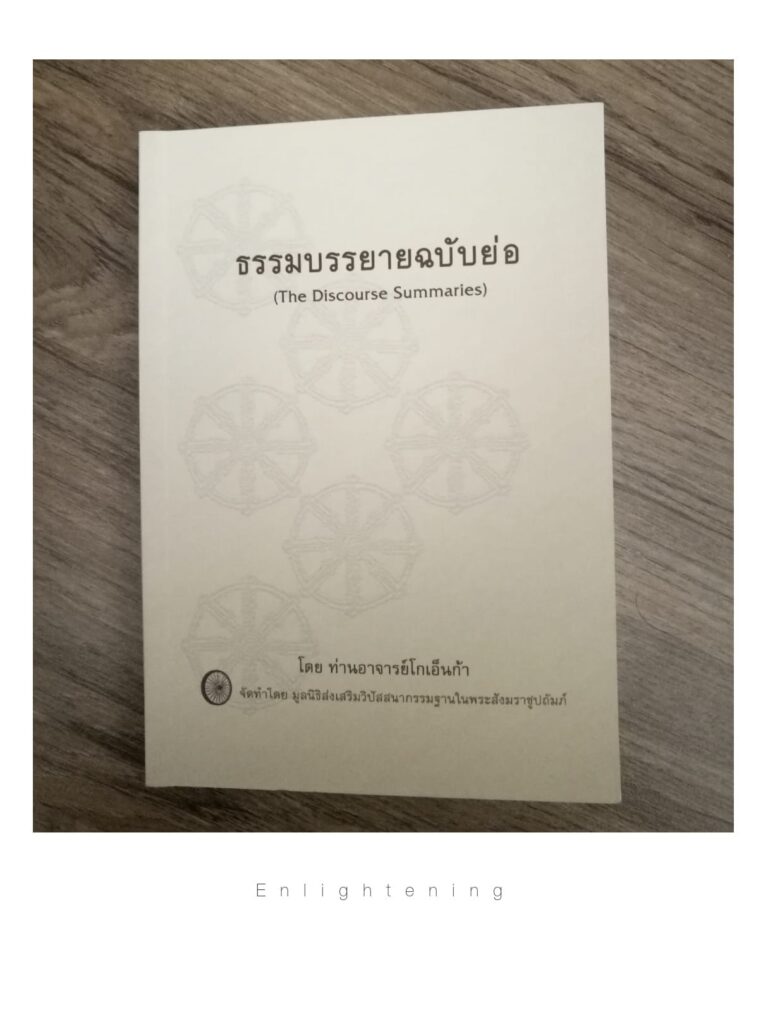Here is a change in book genre and also a change in my reading atmosphere. I picked this book called “The Dhamma Discourse Summaries” by Satya Narayan Goenka (or Ajarn Goenka as known in Thailand) with a hope to calm my anxious and chaotic mind down. The book is a short summary of the formal discourse that is usually ten or eleven days long.

Buddhist Dhamma
Personally, I have studied Dhamma and Buddhist meditation prior to reading this book. I have to admit that the practices stated and explained in this book is quite different from what I have studied.
From what I have studied, when we meditate, it is normal to recite mantra such as “Budho” or “Samma Arahang” in order to make our mind focused. However, the Goenka’s method suggests that we should just observe our breathing without reciting any mantra.
“The Dhamma Dirscourse Summaries” explains so many things regarding the Buddhist Dhamma and mediation and is divided into chapters according to the eleven days of Dhamma Discourse. Each day or each chapter provides a guideline to practising Dhamma and mediation. This includes Ana-Pa-Na-Sati and Vipassana-Kammathan which are the act of meditation and the contemplation on body movements or on focus of breathing on nostrils.
What Else is in the Book?
The book does not only concentrate on meditation, other Buddha’s teachings are also explained. They are:
- The Noble Eight-fold Path – This is the path that leads us to the cessation of sufferings and the achievement of self-awakening.
- The Buddhist Trinity – They are impermanence, state of sufferings and egolessness (or selflessness).
- The Four Noble Truths – They are (1) the truth of suffering, (2) the truth of the origin or suffering, (3) the truth of the cessation of suffering, and (4) the truth of the path to the cessation of suffering.
- The Five Hindrances – These are considered the obstacles to meditation. They are (1) sensual desire, (2) ill-wll, (3) apathy and inertia, (4) restlessness and agitation, and (5) doubt and uncertainty.
The True Wisdom
Personally, I am pretty sure that what “The Dhamma Discourse Summaries” tells us can really be applied to everyday’s life. One of my favourite parts in the book is the “Sammadhitti” part or the “right will” part. This is actually the first of the Noble Eight-fold Path. It is said that “Sammadhitti” is the start towards the true wisdom.
Ajarn Goenka explains through his Dhamma Discourse that there are three stops to wisdom development.
- Sutamaya-Panya which is wisdom resulted from listening and reading
- Jintamaya-Panya which is wisdom resulted from taking Sutamaya-Panya into consideration to see if it is reasonable, believable and practicable towards the cessation of suffering or not
- Powwanamaya-Panya which is wisdom resulted from practising until being awakened or enlightened.
Reading this Dhamma Discourse, I could not help but thinking about today’s world. It is amazing that what the Buddha taught almost 2,600 years ago is still applicable today. An obvious example is in teaching and learning. That is, true wisdom is not something that can be gained very easily if students just read and listen to their teachers. They will need to have an opportunity to think critically as well as to get hands-on experience in active learning so that wisdom can be achieved.
I should probably end my thoughts on and my little summary of “The Dhamma Discourse Summaries” by Ajarn Goenka here. I would like to thank my good friend who gave and introduced me to this wonderful book. It has given me a guideline to practise Dhamma and meditation. At least, it will serve as a gentle reminder that a conscious mind is something to behold.
Sa-Dhu.
